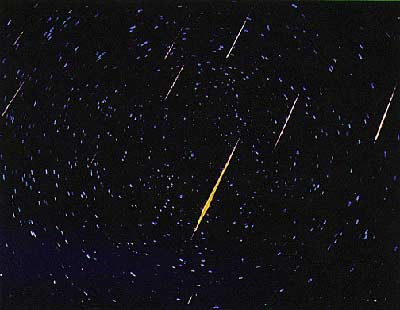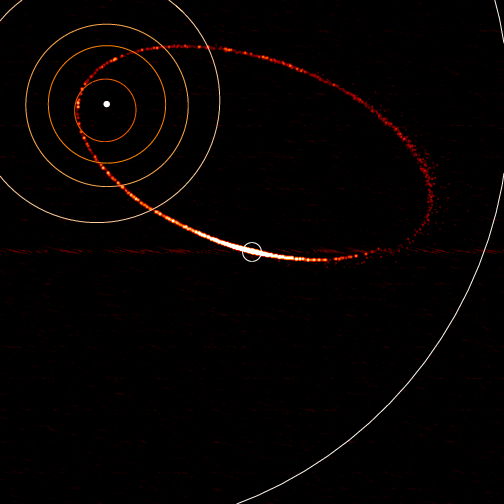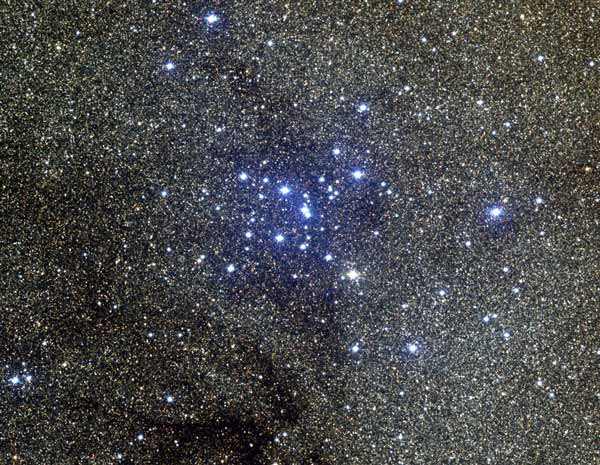"I would rather be a superb meteor, every atom of me in magnificent glow, than a sleepy and permanent planet. The function of man is to live, not to exist. I shall not waste my days trying to prolong them. I shall use my time." -Jack London
Most of you have seen a shooting star before, also known as a meteor.

They happen most frequently during (surprise) meteor showers, but occasionally (and sparsely) during other times of the year. Whenever a small bit of astronomical dust from outer space runs into the atmosphere -- even though it may be no bigger than a grain of sand -- it burns up in the atmosphere from the tremendous heat of friction, creating a spectacular streak of light across the sky.

Of course, they're not actual stars. And really, they're not moving all that quickly. But when the Earth moves through that old, dusty part of space, those grains of cosmic dust are moving fast with respect to the Earth's atmosphere, and the friction from that causes the shooting star you see. The dust comes mostly from old comet trails, and that's why the same meteor showers (e.g., the Perseids, the Leonids, the Quadrantids, etc.) happen around the same time each year, as the Earth passes through the comet's orbit.

But what about real stars? Normally, in our galaxy, although stars whip around the center of our galaxy at a mind-boggling 200+ kilometers per second out where we are, they all go around at more-or-less the same speed.

So does all the gas and dust, and so -- with everything moving similarly -- practically nothing "interesting" happens. But then we come to an interesting star: Mira. Mira is a binary star system, but so are lots of stars. Let's take a look:

Yes, yes, very nice, Hubble. It's a star, congratulations. I'm not impressed, and probably neither are you. In fact, if you look in visible light, there isn't anything impressive going on.

It's bright, I guess, being a red giant and all, but bright stars are a dime-a-dozen. Did you notice in the Hubble image (two up) that there was something weird-looking in the Ultra-Violet image? It turns out that Mira is moving fast: at about 64 km/s relative to the rest of its neighborhood! So NASA's high resolution GALEX satellite took a series of images around Mira, and what did it find? Well, it made this mosaic, below, which you can click on for the ridiculously large full resolution version.

This is a real shooting star! Only a couple of hundred light years distant, it's quite close to us, and moving fast relative to the interstellar medium. The "tail" you see from it comes from heat and friction as the star plows through this interstellar gas and dust at breakneck speeds.
So how the hell did it get to be moving this fast in the first place? Like nearly everything else in the Universe, I blame this on gravity, too. Let me explain.

At lots of places in the Universe, you get clusters of stars together: groups of three or more. You can have globular clusters (above, like M92) with up to millions of stars, open star clusters (below, like M7), with dozens to thousands of stars, or just a group of three or more stars in the same solar system.

What's remarkable about all of these? They're all unstable! This means that, given enough time, all of these systems will eventually start to kick out some of their stars due to gravitational interactions!

We give this a name: violent relaxation. When the old system spits a member out, all of the other members become more tightly bound (i.e., more relaxed), but that's a lower-energy configuration, and we need to conserve energy. So where does it go? It becomes kinetic energy for the mass that gets spit out!
And that's probably what happened to Mira: she was a part of a larger star system that she got spit out from, and that system is now more tightly bound than when she was in it!
So keep a close eye on all your tightly bound star clusters, because it's only a matter of time before another one gets kicked out at a spectacular speed!

Quick, easy-to-understand (even for a relative layman like me) explanation of a really neat topic! Thanks a bunch. This is why I love sciblogs.
Has anyne tried to backtrack the trajectory to determine which cluster ejected it? (I grok the difficulty, but it would be very interesting to know.)
You mention 'friction' being the source of the heat that burns up a meteor and, in this case, causes the heat associated with the Mira plowing through the interstellar medium. But I seem to remember it being compression of, rather than friction with, the ambient atmosphere that caused the heat.
Am I mis-remembering?
Violent relaxation...Wow, now there's two words I didn't expect to see together. Sounds like, forced vacation or extra money, I could use a little of both.
So at this stage of GC's the stellar dynamics of each stars motion upon each other star is of a higher magnitude of importance than the effect of a couple of stars in close proximity.I can see that the quantitative gravitational forces on each star would be principally influenced, but at some point proximity of two star gravitational space metric would override this quasi-stability effect and merge, changing the dynamics of the whole.
We can use the n=body problem to calculate future shooting stars...Are we there yet?
On a super cluster scale if we thought of the Black holes as in a cluster would we see the violent relaxation on a much longer and grander scale or is the homogenization and expansion of the gravity field not irregular enough to produce shooting galaxies?
Does the particle precipitation delivered by the sun to the other solar system bodies (according to their composite) influence their trajectories, given the minor factor of mass accumulation,over time.
Since all bodies would not accumulate mass in the same way, does this, overtime,lead to a dynamical solution of some degree?
How much mass does the earth acquire through particle precipitation compared to meteor deposits?
Sphere Coupler, we'd love to be able to predict ejections from actual star clusters and globular clusters, but the systems are too chaotic. Even if we knew all components of the stars' velocities and their exact positions (which we don't), our N-body simulations can only predict the average rate of ejection.
But, as an aside, we think that this process, that kicked a star out of a cluster, is the same type of process that kicked the famous globular cluster in Abell 1185 around. There's actually a new paper out on finding a group of globular clusters that are in between clusters: http://www.sciencemag.org/cgi/content/abstract/328/5976/334
Mike, you are technically correct. We sometimes use the word "friction" as a general term for any two things rubbing together or where a moving object enters a gas or liquid that resists its motion. But you are correct, that most of the heat comes from fast, adiabatic compression of the air in front of it.
Due to the extra money situation, I am happy to report that I was able to read the paper on arvix and found it quite compelling.
So then shooting globular clusters (as I perceived them)(IGC,s)seem to be a reality.
Metal poor globular clusters stripped from Dwarf Galaxies, possibly along with dark matter and I would suspect a fair amount of gas, eventually ending up accreting to the largest mass(or intermittently accreting to any larger mass if in the right spot at the right time) within the chaos of the Super cluster, influenced by the Galaxies in the Super cluster.
So perhaps this function could be looked upon as a intergalactic eddy, I still if wonder extrapolating this procedure could also explain isolated galaxies not associated with super clusters, could mass transfer take place between SC's at this stage(the present)or have we expanded too far and too fast for SC's to exchange mass.
If violent relaxation does not have it's limits then the delaying of total accretion could continue almost indefinitely.
The paper suggest that these IGC's may follow the dark matter as it is ripped from it's parent galaxy.Logically following then interacting intergalactic eddies of DM,GC,s and gas could turn out to be quite common, and even more common... eddies of DM and Gas, and even more common...eddies of DM.
Given the life expectancy of a GC,could a specific globular clusters be passed from one galaxy to another?If they could then this would be an information exchange on a very large scale.
Thanks for the *heads up* link.
"Given the life expectancy of a GC,could a specific globular cluster be passed from one galaxy to another?If they could then this would be an information exchange on a very large scale."
What I meant was, could a specific GC be passed more than once between galaxies.(like a beach ball in a 1950's movie)
Shpere Coupler,
What a tale that traveler would have to tell!
But we still don't know why they don't eject all their kinetic energy and collapse. Right?
hi
TnA;
.
..
...Indeed!
2 nice
2013 Dec
ALL THAT EVER LIVED ON EARTH WILL SOON HAVE THEIR EYES TO THE HEAVENS
Do a little History on this one.
ALL Should Look Up "2012 DA14".
This could take out one of more satellites and the junk and debris from the hit could end up taking out many more satellites very soon after that. All the satellite collision probability will go way up if even one is hit. The velocity that the parts would go to would make them missiles that would start targeting a chain reaction this would not be good.
Most all will be watching this one and pray it goes by us without a hit. Every Scientist alive will be watching this event. Many will be in Florida for a very special viewing of the once in a Lifetime Event. Professors, Scientist, World Leaders, Ham Radio Operators and Every Astronomer will have its eyes on This Event, along with almost every TV set on Earth.
"2012 DA14" goes by Earth twice a year and there is no way anyone for sure, can tell how close the second pass will be till it passes by the Moon and Earth and the GRAVITATIONAL FORCE effect that it will have on this Asteroid.
They may come close but this one is already coming very close to begin with. Too close this time or on its second or 3rd pass? Ad a Meteor Shower like the 13 and 14 of December of 2012, it might go through or bump into one of them? Or all the other more then 20,00 pieces of orbital debris like Spent Rocket Boosters left in space that can no longer be moved by a control center on Earth. Or add a Solar Flare. Or a Comet ISON or its tail debris of millions of rocks of all sizes.
If a big enough one were to slam into the moon in the night sky you would think the sun was coming up early only it would be 5 to 7 times as bright. From The Sun's Rays Reflection on all the Debris Field.
2012 XM16, 2012 XM55, 2012 XP55, THERE ARE OVER 25 found just in the year 2012 that are part of the Near Earth Object Program that will come close to Earth from now till 2012 DA14 comes, Feb 14 - 16, 2013.
You do not want to know how many are on the "PLANETARY DEFENSE" list.
The PLANETARY DEFENSE is not to protect Earth from men from Mars.
It is for all mankind with most all Nation in on it to stop if can most all collision with EARTH from a ASTEROID IMPACT. It is if you will a AVOIDANCE SHIELD. "N.E.O.S. Near Earth Object Shield".
If only one were to hit or IMPACT EARTH on land get ready for a winter you will never forget. The winter from 1883 -1884 KRAKATOA you will think was a little pebble, and now the stone comes.
A Shock Wave was felt in England from a Event about 7:15 to 7:20 A.M. Siberia time in the morning in June of the year 1908 high in the sky above the Forest in the remote wilderness of Tunguska Siberia heard an explosion that laid flat more than 800 square miles of the forest with all the trees pointing away from the center of the blast with most all the trees laying on their side. Some trees that were right below the blast were still there looking like telephone poles with no bark or branches left on them. This Asteroid did not even hit the Ground and this is known by most as the TUNGUSKA EVENT. For all that lived there it was WORMWOOD Rev 8:11 the wood became full of worms and the rivers water no longer sweet and undrinkable.
If a Meteor Shower is big enough you might think all the stars are falling from Heaven.
About one every 100 years makes it into the Earth’s Atmosphere big enough for all to take note. Some make it to the surface the signs are all over the Planet and moon from the ones that have.
If you need a visual sign of a collided impact with a planet look to
"SHOEMAKER - LEVY 9" July 1994.
You Need More Look up "PROJECT WORMWOOD" Revelations 8: 10 - 11 based on the "TUNGUSKA EVENT" 1908
Better to be safe then sorry.
GET READY
Read your Bible
While you still can,
and May our Lord GOD Bless all that do so.
John 14 : 6
Luke 13 : 27
Matthew 7 : 20 - 27
Matthew 12:39
Matthew 24:3 - 14
The Lord's Little Helper.
Paul Felix Schott.
December 2013 the Heavens above COMET "C/2012 S1", "ISON".
ALL ON EARTH WILL SEE THIS NO MATTER WHERE YOU ARE. the night side of earth will become day and and day will be blinding bright.
Shortly there after you will think the stars are falling from the Heavens, from ISON long tail Jan 1-4, 2014 if it dose not consume Mars first and makes it around the SUN without the sun consuming it.
P.S.
Help others in are Lord's name Jesus Christ help bring all to know him while you still can.
Three kings that were wise men once flowed a star with a long tail 2,000 years ago. That lead them to Jesus Christ wise men still look to and hear are Lord Jesus Christ.